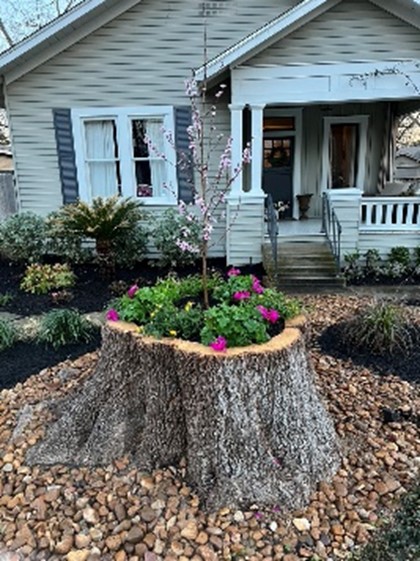by Josie Seeligson, Bexar County Master Gardener
January 2023

More than 20 years ago, my husband and I bought a property in rural South Texas, and I started planting. Besides a few heritage live oaks and mesquite trees, there was little shade, color, or interest in and around the house and barn compound.
But deep South Texas has magically transformed many dusty properties to virtual oases by adding palm and shade trees and using creative planting and space designs. We planted the fast-growing and readily available Washingtonia robusta/ Mexican Fan palms, because even with a limited budget, young plants could be bought, and we could “just add water.”
Trial and error proved that palms planted near the slant of a roof grew far more swiftly from draining rain or even dripping morning dew. In contrast, those planted farther from a water source or too close to a water-sucking mesquite tree, grew at a snail’s pace compared to its peers in more fortuitous locations.
Within years, I was growing and pruning my own oasis, decorated with yard art whimsy and an assortment of shade trees, perennials, vegetables, fruit and olive trees, and cactus groupings. Washingtonia palm trees were scattered throughout, some piercing oak canopies or flanking metal rooflines and repurposed garden beds.
So I was devastated, like many gardeners, after the “Snovid” event in February 2021—when we experienced temperatures below 10 degrees for many days, overwhelming the state’s electric grids and water systems and wiping out native landscapes across Texas.
Losing perennials, citrus, and other plants is expected in Texas during hard freezes, but this particular freeze decimated normally hardy plants, large specimens of yucca, agave, and entire patches of spineless prickly pear.
The mass graveyards around our compound were depressing to observe and difficult to remove. Nothing, though, was sadder than the loss of the palm trees. Of the 26 Washingtonias planted over 23 years ago, only five survived. I’d bought them slowly and small—but to try to replace them at the heights they’d reached would be a huge financial investment.
Finally certain they were not coming back, and unable to look at them any longer, I announced to my husband that we were cutting them down! Out came the tractor, chain saw, truck hitch with heavy chain, and shovels.
And very soon, I had to acknowledge my second mistake (the first of course, was to have planted a near-monoculture of palm trees): I had underestimated the resilience of a dead palm trunk. Through the years, any time we’d lost a shade or fruit tree, we simply chopped down the dead tree. If the stump needed help decomposing and disappearing, then shovels, electric saws, and occasional tricks like diesel and a match made removal easy.

Not so with a palm trunk. I’d never had one die, and certainly not 21 all at one time. It was difficult to dig them up without machinery or remove their dense root ball by digging, chopping, pulling, or even burning. The inside of a palm is like a coral reef—a petrified fibrous catacomb, and a master of resilience.
The tallest dead palms proved daunting; just to access crowns, we first had to pull down the mass of “petticoat” dead fronds and boots. This task was not only messy, with brittle debris raining from above, but precarious too, as hornets (or worse) often nest in dead fronds, and the work had to be done high up on an extension ladder. Next, my husband used the chain saw to remove the crown, and I braced the ladder and spotted from the ground. We weren’t sure in which direction the crown would fall, so, to avoid injury, I’d bang the side of the metal ladder to get his attention.
Since then, I have further flagellated myself for my impatience to remove them as I’ve now seen and researched creative ways to address dead palm stumps. This fall, we finally took a stab at getting creative with the remaining palm stumps. My husband pulled out an assortment of drill bits and drilled multiple holes in the centers, leaving a thick circumference. We then removed trunk pith and added soil and selected agaves I’d harvested from mother sources.
You can put anything you want in trunk “planters,” especially if they’re lower to the ground and easy to access. This task is far easier with shorter stumps–palm or hardwood alike. Once the center is scooped out, almost anything can be planted inside like a regular pot. Ours are still rough, but much more attractive now that they are brimming with life.
All photos by Author
